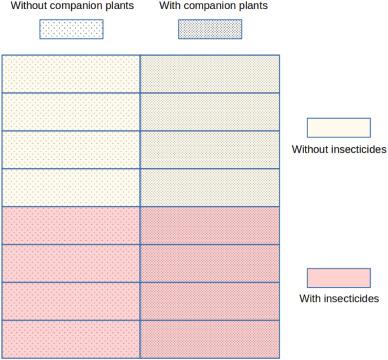当前位置:
X-MOL 学术
›
Crop Prot.
›
论文详情
Our official English website, www.x-mol.net, welcomes your feedback! (Note: you will need to create a separate account there.)
Efficacy of neonicotinoid and non-neonicotinoid treatments on virus yellows and sugar beet yields
Crop Protection ( IF 2.8 ) Pub Date : 2024-03-11 , DOI: 10.1016/j.cropro.2024.106658 Armand Favrot , Fabienne Maupas , Cédric Royer , Elma Raaijmakers , Chloé Dufrane , André Wauters , David Makowski
Crop Protection ( IF 2.8 ) Pub Date : 2024-03-11 , DOI: 10.1016/j.cropro.2024.106658 Armand Favrot , Fabienne Maupas , Cédric Royer , Elma Raaijmakers , Chloé Dufrane , André Wauters , David Makowski

|
(Sulzer), commonly known as the green peach aphid, plays a pivotal role in transmitting a range of yellowing viruses, including beet yellows virus, beet mild yellowing virus, beet chlorosis virus, and beet mosaic virus, to sugar beet plants ( L.). Because of their environmental impacts, three neonicotinoid-based products (imidacloprid, thiamethoxam, and clothianidine) have faced recent bans in multiple countries and there is thus an increasing need to explore alternative and effective methods for aphid control.In this study, we assess the efficacy of seven conventional aphicides, one neonicotinoid seed treatment, two foliar-applied neonicotinoids, and four companion plants in mitigating the propagation of virus yellows and increasing sugar beet yields. Our analysis is based on data obtained from 64 trials conducted from 2018 to 2023 in France, Belgium, and the Netherlands. These trials were analyzed using linear mixed-effect models in order to estimate the efficacy of neonicotinoid and non-neonicotinoid treatments on the virus yellows and the sugar-beet yields.Our results revealed that the neonicotinoid seed treatment thiamethoxam exhibited strong efficacy in both reducing virus yellows and enhancing yields compared to alternative treatments. However, the most effective treatment for reducing virus yellows was a composite treatment combining barley companion plant, spirotetramat, and flonicamid, which led to an 87.0% reduction in virus yellows incidence compared to the untreated control group [95% confidence interval = (73.3; 93.6)]. In terms of sugar beet yields, spirotetramat at a dosage of 0.75 l/ha proved to be the most effective treatment, resulting in a 15.7% increase in yields compared to the untreated group [95% confidence interval = (9.1; 22.6)]. While companion plants were able to reduce virus yellows, they did not significantly increase yields compared to the untreated treatment. This outcome may be attributed to the competitive interactions between companion plants and sugar beets, in the context of dry seasons. Furthermore, our analysis indicated that the impact of spirotetramat, sulfoxaflor, flonicamid and thiamethoxam on yields tended to increase with higher aphid pressures.
中文翻译:

新烟碱类和非新烟碱类处理对病毒黄化和甜菜产量的功效
(Sulzer),俗称绿桃蚜,在向甜菜植物传播一系列黄化病毒方面发挥着关键作用,包括甜菜黄化病毒、甜菜轻度黄化病毒、甜菜失绿病毒和甜菜花叶病毒。 )。由于对环境的影响,三种新烟碱类产品(吡虫啉、噻虫嗪和噻虫胺)最近在多个国家面临禁令,因此越来越需要探索替代和有效的蚜虫控制方法。在这项研究中,我们评估了七种传统杀虫剂、一种新烟碱类种子处理剂、两种叶面喷施新烟碱类杀虫剂和四种伴生植物在减轻病毒黄化传播和提高甜菜产量方面的功效。我们的分析基于 2018 年至 2023 年在法国、比利时和荷兰进行的 64 项试验获得的数据。使用线性混合效应模型对这些试验进行了分析,以评估新烟碱类和非新烟碱类处理对病毒黄化和甜菜产量的功效。我们的结果表明,新烟碱类种子处理剂噻虫嗪在减少病毒和甜菜产量方面表现出强大的功效与替代处理相比,黄化并提高产量。然而,减少病毒黄化最有效的治疗方法是结合大麦伴生植物、螺虫乙酯和氟啶虫酰胺的复合治疗,与未处理的对照组相比,病毒黄化发生率降低了 87.0% [95% 置信区间 = (73.3; 93.6)]。就甜菜产量而言,0.75升/公顷剂量的螺虫乙酯被证明是最有效的处理方法,与未处理组相比,产量增加了15.7%[95%置信区间=(9.1;22.6)]。虽然伴生植物能够减少病毒黄化,但与未经处理的处理相比,它们并没有显着提高产量。这一结果可能归因于旱季背景下伴生植物和甜菜之间的竞争性相互作用。此外,我们的分析表明,螺虫乙酯、氟啶虫胺、氟啶虫酰胺和噻虫嗪对产量的影响随着蚜虫压力的增加而增加。
更新日期:2024-03-11
中文翻译:

新烟碱类和非新烟碱类处理对病毒黄化和甜菜产量的功效
(Sulzer),俗称绿桃蚜,在向甜菜植物传播一系列黄化病毒方面发挥着关键作用,包括甜菜黄化病毒、甜菜轻度黄化病毒、甜菜失绿病毒和甜菜花叶病毒。 )。由于对环境的影响,三种新烟碱类产品(吡虫啉、噻虫嗪和噻虫胺)最近在多个国家面临禁令,因此越来越需要探索替代和有效的蚜虫控制方法。在这项研究中,我们评估了七种传统杀虫剂、一种新烟碱类种子处理剂、两种叶面喷施新烟碱类杀虫剂和四种伴生植物在减轻病毒黄化传播和提高甜菜产量方面的功效。我们的分析基于 2018 年至 2023 年在法国、比利时和荷兰进行的 64 项试验获得的数据。使用线性混合效应模型对这些试验进行了分析,以评估新烟碱类和非新烟碱类处理对病毒黄化和甜菜产量的功效。我们的结果表明,新烟碱类种子处理剂噻虫嗪在减少病毒和甜菜产量方面表现出强大的功效与替代处理相比,黄化并提高产量。然而,减少病毒黄化最有效的治疗方法是结合大麦伴生植物、螺虫乙酯和氟啶虫酰胺的复合治疗,与未处理的对照组相比,病毒黄化发生率降低了 87.0% [95% 置信区间 = (73.3; 93.6)]。就甜菜产量而言,0.75升/公顷剂量的螺虫乙酯被证明是最有效的处理方法,与未处理组相比,产量增加了15.7%[95%置信区间=(9.1;22.6)]。虽然伴生植物能够减少病毒黄化,但与未经处理的处理相比,它们并没有显着提高产量。这一结果可能归因于旱季背景下伴生植物和甜菜之间的竞争性相互作用。此外,我们的分析表明,螺虫乙酯、氟啶虫胺、氟啶虫酰胺和噻虫嗪对产量的影响随着蚜虫压力的增加而增加。



























 京公网安备 11010802027423号
京公网安备 11010802027423号